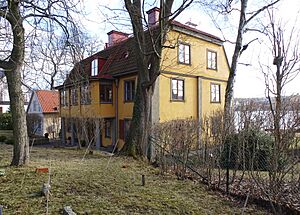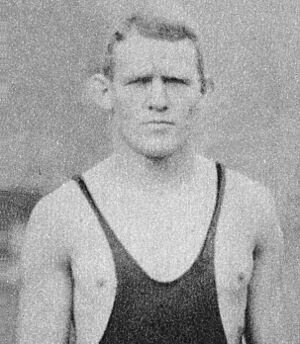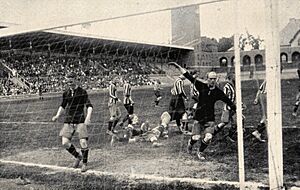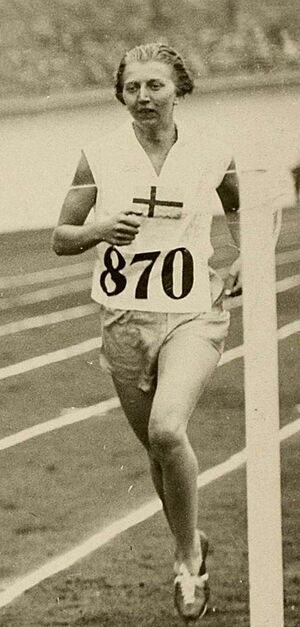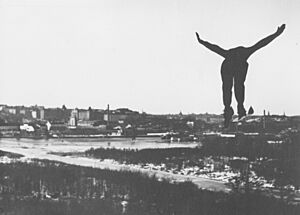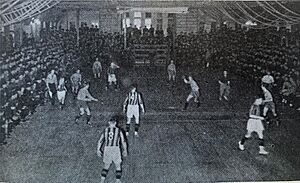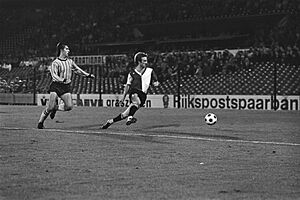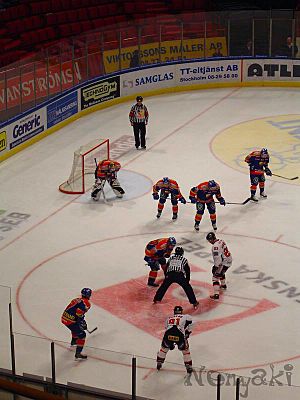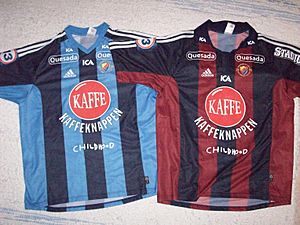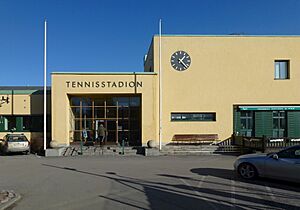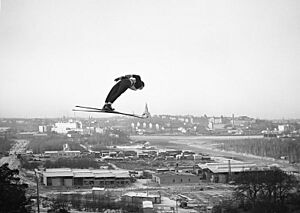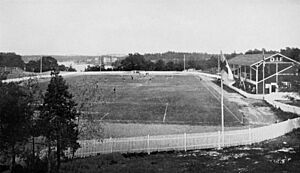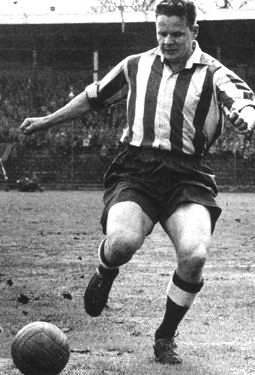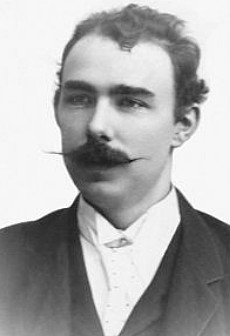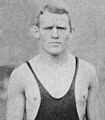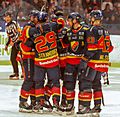Djurgårdens IF facts for kids
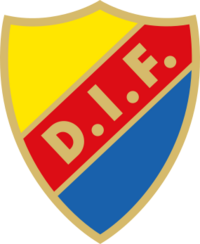 |
|
| Founded | 12 March 1891 |
|---|---|
| Based in | Stockholm, Sweden |
| Stadium | 3Arena (men's football) Stockholm Olympic Stadium (women's football) Hovet (ice hockey) Östermalms IP (bandy) |
| Colours | yellow, red, blue |
| Chairman | Andreas von der Heide |
| Official fan club | Järnkaminerna |
Djurgårdens Idrottsförening, often called Djurgårdens IF or just Djurgården, is a big Swedish sports club from Stockholm. It's also known as Dif or DIF. Since 1991, Djurgårdens IF has been an "alliance club." This means it's made up of 22 different sports clubs, each focusing on a specific sport.
Contents
Club History
How Djurgården Started (1891–1896)
The club began in 1891. A group of young athletes living in the Djurgården area of Stockholm decided to create it. They were inspired by ski jumping shows in Stockholm. These young people often competed against each other in different sports.
On March 12, 1891, John G. Jansson, who was 22, and about a dozen friends founded Djurgårdens IF. They met at a café on Alberget 4a. Jansson became the first chairman. Many of the founders were from working-class families. Djurgården kept this focus for a long time. This was different from their rival club, AIK, which was more for middle-class people. At first, only people living on Djurgården island could join. But this rule was soon changed.
The club first focused on winter sports and athletics. But it quickly grew to include many other sports. Djurgården became one of Sweden's most successful sports clubs.
Early Wins (1897–1923)
In 1897, Gustaf Söderström became Djurgårdens IF's first Swedish champion. He won the shot put in athletics. He won again the next year and also the discus throw. Söderström even won a gold medal in tug of war at the 1900 Summer Olympics. Another club member, Karl Gustaf Staaf, was also on that winning team.
The football team started in 1899. Their first game was a 1–2 loss against AIK. Soon, a strong rivalry began with AIK. Both clubs were founded within a month of each other in 1891. They play in a famous match called the Tvillingderbyt.
In 1904, Djurgården won its first Swedish speed skating championship. This was thanks to Birger Carlsson. The swimming section of the club left in 1906 to start their own club, SK Neptun.
In 1908, the bandy team won its first national title. Women were allowed to join the club in 1908. In 1909, Tage Carlsson won the club's first national cycling title.
In 1910, N. A. Hedjerson won the first Swedish cross-country skiing championship. That same year, Einar Olsson won the club's first Swedish titles in Nordic combined and ski jumping. Olsson became a national champion in many sports. In 1911, Hedjerson and the Sandström brothers won the club's first Swedish ski orienteering relay title.
In 1911, Gottfrid Svensson became Djurgården's first Swedish wrestling champion. He won the Greco-Roman lightweight event. He repeated this win in 1912 and 1913. Also in 1911, Bertil Gustavsson won the club's first weightlifting championship.
From 1911, Djurgårdens IF used the Tranebergs IP sports ground. In 1912, the bandy team won its second national title. At the 1912 Summer Olympics, Djurgården athlete Erik Almlöf won a bronze medal in the men's triple jump. That same year, the men's football team won its first national championship. They won again in 1915, 1917, and 1920.
From 1913 to 1919, Djurgården ski jumpers won seven national championships in a row. In 1920, the club won its first boxing title. At the 1920 Summer Olympics, Djurgården wrestler Gottfrid Svensson won a silver medal. Another Djurgården wrestler, Fritiof Svensson, won a bronze medal at the same Olympics. In 1922, Fritiof Svensson became a wrestling world champion. In 1922, the ice hockey team played its first season.
Growing Stronger (1924–1939)
In 1924, Djurgården won its first Swedish championship in a women's event. This was in cross-country skiing. At the 1924 Summer Olympics, Djurgården footballer Harry Sundberg was part of Sweden's bronze medal-winning football team.
In 1926, the ice hockey team won its first Swedish championship. They beat Västerås IK 7–1 in the final. The men's football team played in the top league, Allsvenskan, for the first time in the 1927–28 season. But they only stayed for one season. At the 1928 Winter Olympics, two Djurgården ice hockey players helped Sweden win a bronze medal. In 1928, Bertil Nordenskjöld, a former football player, became the chairman of Djurgården.
In 1928, Djurgårdens IF won its first four Swedish women's athletics titles. Ebba Myrberg won the 100 metres and long jump. Inga Gentzel won the 800 metres. A team also won the 4 × 100 metres relay. This was the first championship where women competed. Later that year, Inga Gentzel won a bronze medal in the 800 metres at the 1928 Summer Olympics.
At the 1928 Summer Olympics, Djurgården boxer Nils Ramm won a silver medal. In 1931, the bandy team played in the first national bandy league. At the 1932 Summer Olympics, Djurgården wrestler Einar Karlsson won a bronze medal. In 1933, Östen Eriksson became the club's first national bowling champion.
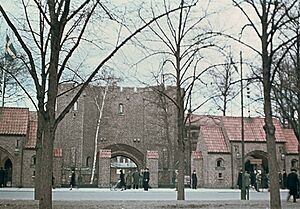
The ice hockey team stopped playing after the 1933–34 season because it cost too much. In 1935, Djurgårdens IF had to leave Tranebergs IP. From 1936, the club used the Stockholm Olympic Stadium for football.
From 1936, Olle Tandberg won five national boxing titles in a row. At the 1936 Summer Olympics, Djurgården wrestler Einar Karlsson won another bronze medal. In 1937, the club won its first Swedish alpine skiing titles.
In 1938, the men's handball team reached the national championship final but lost. After a break, in 1938, Djurgården restarted the ice hockey team. By 1939, Djurgårdens IF had won 167 Swedish championship titles.
The 1940s
In 1941, the women's cross-country skiing team won the 10 km team event. They repeated this in 1942 and 1943. In 1942, Bertil Nordenskjöld stepped down as chairman after 14 years. During the 1940s, the women's bandy team played in a league in Stockholm.
In 1948, the club won its first Swedish table tennis titles. Tage Flisberg won the men's singles and other events.
Golden Years in Football and Ice Hockey (1950–1969)
The 1950s and 1960s were a great time for Djurgårdens IF. They won nine Swedish ice hockey titles and four Swedish football titles.
In 1950, the men's ice hockey team won its second national title. Between 1952 and 1964, Edvin Vesterby won ten national wrestling titles. At the 1952 Winter Olympics, five Djurgården ice hockey players helped Sweden win a bronze medal. At the 1952 Summer Olympics, Djurgården footballer Gösta Sandberg was part of Sweden's bronze medal-winning team.
In 1954, the men's ice hockey team won its third national title. They won again in 1955. In 1955, the men's football team won its fifth national title. From 1955, the Djurgården women's table tennis team won six national championship titles in a row. At the 1956 Summer Olympics, Djurgården wrestler Edvin Vesterby won a silver medal.
In 1955, the men's football team played in a European competition for the first time. They won their first match against Gwardia Warsaw.
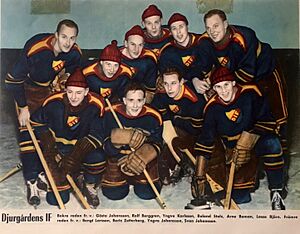
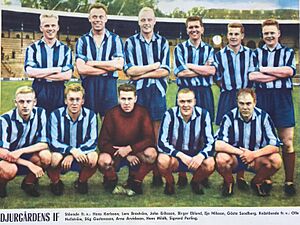
In 1958, the men's ice hockey team won its fifth national title. They then won six titles in a row until 1963. In 1959, the men's football team won its sixth national title. Some players, like Hans Mild, Sven Johansson, and Gösta Sandberg, played on both the ice hockey and football teams and won titles in both sports in 1959.
From 1959, Kathinka Frisk won the alpine skiing downhill event four times in a row. In 1960, the club won its first Swedish tennis titles. In 1961, the men's bandy team returned to the top league. In 1962, Djurgården won its first national fencing title. The next year, Orvar Lindwall became the first individual fencing champion for Djurgården.
At the 1964 Winter Olympics, four Djurgården ice hockey players helped Sweden win a silver medal. In 1964, the men's football team won its seventh national title. In 1966, they won their eighth national title.
From 1965 to 1969, Britt Elfving won five Swedish Figure Skating Championships in a row. In 1965, the club also won its first bobsleigh title.
In 1969, the women's football team started playing in a league and won it.
The 1970s and 1980s
From 1972, the Djurgården men's fencing team won four titles in a row.
In 1974, Sören Johansson was the first Djurgården player chosen in the NHL entry draft. At the 1976 Summer Olympics, Djurgården fencers helped Sweden win a gold medal in the men's team épée event.
At the 1980 Winter Olympics, four Djurgården ice hockey players helped Sweden win a bronze medal. In 1983, the men's ice hockey team won its eleventh national title. At the 1984 Winter Olympics, seven Djurgården ice hockey players helped Sweden win a bronze medal.
From 1987, the men's épée fencing team won three national titles in a row.
At the 1988 Winter Olympics, four Djurgården ice hockey players helped Sweden win a bronze medal.
At the 1988 Summer Olympics, Djurgården boxer Lars Myrberg won a bronze medal.
New Structure and More Wins (1989–1999)
In 1989, the men's ice hockey team moved to Globen. They won the national title in 1989, 1990, and 1991. The men's handball team stopped playing in the 1989–90 season. The ice hockey team also won the IIHF European Cup in 1990 and 1991.
Around 1990, Djurgården faced money problems. To fix this, the club decided to split into separate parts in 1991. The one big club became 16 smaller clubs. That same year, Djurgården celebrated its 100th birthday. Gösta Sandberg was chosen as Djurgården's person of the century. In the 1991–92 season, the men's floorball team started playing.
At the 1994 Winter Olympics, Djurgården ice hockey players Charles Berglund and Christian Due-Boje helped Sweden win a gold medal. In 1996, Djurgården became Swedish champions in pétanque for the first time. In 1999, the women's football team became Swedish champions in indoor five-a-side football.
In 1999, the bandy team stopped playing but restarted in 2000.
Into the New Millennium (2000–2006)
In 2000, the men's ice hockey team won its 15th national title. They won again in 2001.
In 2002, for the first time in 36 years, the men's football team won its ninth Swedish championship. They won again in 2003, getting their tenth national title.
For the 2003 season, the women's football club joined with Älvsjö AIK to form Djurgården/Älvsjö. This new team won the top league, Damallsvenskan, in its first year and again the next season. In 2005, Djurgården/Älvsjö reached the UEFA Women's Cup final but lost. In 2005, the men's football team won its eleventh national title.
Recent Years (2006–Present)
In 2006, the men's football club became a company. The ice hockey club did the same in 2008.
From 2006, Bashir Hassan won five national boxing titles in a row. In 2007, the men's ice hockey team moved back to Hovet.
In April 2011, the women's floorball team won Djurgårdens IF's first Swedish championship title in floorball. In March 2012, the men's ice hockey team was moved down from the top league. In 2013, the men's handball first team stopped playing.
In late 2013, Djurgårdens IF men's and women's football clubs joined into one club. In 2014, Djurgården started a women's ice hockey team. In 2016, the martial arts club won its first two Swedish championship titles. At the 2016 Summer Olympics, Djurgården footballer Emilia Appelqvist was part of Sweden's silver medal-winning women's football team. In March 2017, the women's ice hockey team won its first national title.
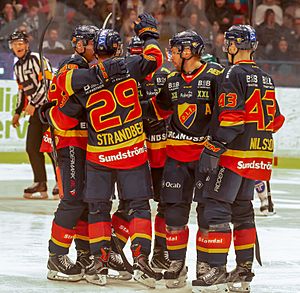
In 2019, the men's football team won its twelfth national title. In the 2019–20 season, the men's basketball team played in the top league for the first time. In 2020, the football and ice hockey clubs started working with schools to help kids be more active. In the 2020s, Djurgården added cricket, padel, and chess to its sports. In 2022, the cricket club became Swedish champions in the women's event. Also in 2022, a women's beach soccer Swedish championship title was added. At the end of the 2021–22 season, the men's ice hockey team was moved down from the top league.
On January 1, 2023, the two main football teams became one financially. In 2023, the ice hockey club borrowed money from the football club to help with costs.
Club Emblem and Colours
The club's first emblem was a silver star with the letters DIF. The current emblem, a shield in yellow, red, and blue with "D.I.F." on it, was adopted in 1896. Blue and yellow are the colours of Sweden and Stockholm. Red stands for love.
Yellow, red, and blue are the club's official colours. The logo and colours are carefully set to specific shades. In many sports, like football, bandy, and handball, the home jersey is striped in light and dark blue. This is why blue is often seen as the most important colour. The ice hockey team uses blue jerseys with yellow and red details.
In other sports, Djurgården has used black shirts with blue stripes (for athletics and boxing) and blue shirts with the club badge (for wrestling).
In a 2024 study about the strongest sports brands in Sweden, Djurgårdens IF was ranked second.
Sports Played by Djurgården
Djurgårdens IF has many different sections, each like its own club. They all share the same name, logo, and values. They also support each other.
As of 2025, the club has won 478 Swedish championships in 25 different sports!
List of Sports
| Sport | Started | Home venue | Notes | |
|---|---|---|---|---|
| alpine skiing | 1930s | Hammarbybacken | ||
| athletics | 1892 | Stockholm Olympic Stadium | restarted 2024 | |
| bandy Djurgårdens IF Bandy |
Östermalms IP, Gubbängens bandyhall | took a break 1999–2000; joined with Spånga/Bromstens BK for the 2014–15 season | ||
| basketball Djurgårdens IF Basket |
2015 | |||
| bowling | 1919 | |||
| boxing Djurgårdens IF Boxningsförening |
unknown | |||
| chess | 2023 | |||
| cricket | 2020 | Skarpnäcks cricketplan | Stockholms Akademiska Cricketsällskap joined Djurgårdens IF in 2020 | |
| cycling | unknown | restarted 1960 | ||
| fencing Djurgårdens IF Fäktförening |
1958 | Djurgårdens fäktsal, Hjorthagshallen | ||
| figure skating | ||||
| floorball | 1990 | Hjorthagshallen | women's team created from Balrog Botkyrka IK in 2010; men's team joined with Capeirotäby FC in 2014 | |
| football | (men's football) Djurgårdens IF Fotboll |
1899 | 3Arena | women's club joined with Älvsjö AIK for the 2003 season; women's club joined the men's club in 2013; men's and women's first team are now one company |
| (women's football) Djurgårdens IF Fotboll (women) |
Stockholm Olympic Stadium | |||
| futsal | Hjorthagshallen | |||
| beach soccer | ||||
| football (para) | 1997 | Hjorthagens IP | ||
| golf | 1996 | |||
| handball Djurgårdens IF Handboll |
1934 | Hjorthagshallen | took a break 1990–2000; men's team joined with BK Söder in 2002; took a break from 2013 | |
| ice hockey | (men's) Djurgårdens IF (men's hockey) |
1922 | Hovet | took a break 1934–1938; women's team created from Segeltorps IF in 2014 |
| (women's) Djurgårdens IF (women's hockey) |
||||
| martial arts | 2013 | Stockholm Olympic Stadium | ||
| padel | 2020 | |||
| pétanque | 1995 | Liljeholmshallen | ||
| table tennis | 1947 | |||
| wrestling | 1911 | Vällingbyhallen | ||
Club Venues
Venues in Central Stockholm
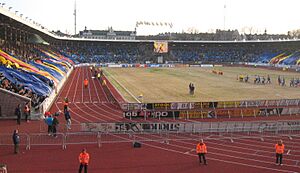
The Stockholm Olympic Stadium has been home to many Djurgårdens IF sports. It was the home for the men's football team until 2013. It has been their home since 1936. The Olympic Stadium is still the home for the women's football team. The athletics club also uses the stadium. The men's ice hockey team used the Olympic Stadium from 1922 until 1962. The club has a trophy room at the stadium.
Östermalms IP is used for bandy since 2017. It has also been used by the women's football team.
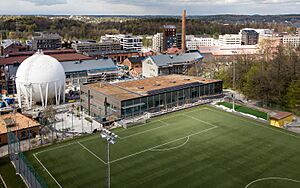
Hjorthagens IP has been home to the women's football team. It is now home to the para football club. Nearby, Hjorthagshallen was built in 2019. It is home to the floorball, handball, fencing, and futsal teams.
Kungliga tennishallen was used for the men's basketball team's first top-league home match in 2019.
Tennisstadion was used for tennis and curling in the past. Fiskartorpsbacken was used for ski jumping.
The wrestling club has been in Vällingbyhallen since 1988.
Venues in Southern Stockholm
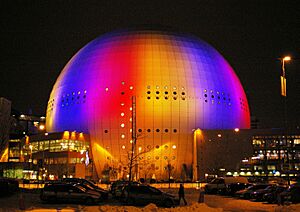
Hovet was used by the men's ice hockey team from 1955 until 1989. It has been their home again since 2007.
Avicii Arena was the home arena for the men's ice hockey team between 1989 and 2007. 3Arena is used by the men's football team since 2013.
Eriksdalshallen has been used for boxing events and is home to the men's handball team. Zinkensdamms IP has been used by the bandy team.
Hammarbytoppen was used for ski jumping and alpine skiing. Hammarbybacken at Hammarbytoppen is now home to alpine skiing.
Gubbängens bandyhall is used for bandy when outdoor play is not possible. Skarpnäcks cricketplan is home to the cricket club.
Venues in Western Stockholm
Tranebergs IP was home to the men's football team from 1911 to 1935. Stora mossens IP has been used by the women's ice hockey team and for figure skating.
Supporters and Fan Culture
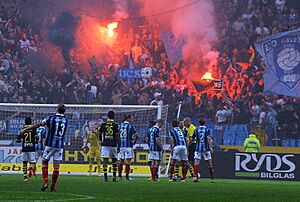
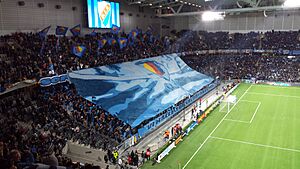
Djurgården is one of the most popular clubs in Sweden. Most of its fans live in Stockholm and nearby areas. While other Stockholm clubs are known for specific parts of the city, Djurgården is seen as a club for all of Stockholm.
In 1981, the main fan club "Blue Saints" was formed. But because of some fans' bad behavior, the club changed its name to Järnkaminerna. This name means "the Iron Furnaces" and was an old nickname for Djurgården athletes from the 1950s. Sofia Tifo is Djurgården's group that creates large, artistic displays at games.
Djurgården is special because it's one of the few clubs represented in space (by astronaut Christer Fuglesang) and in the Himalayas.
Many souvenirs are sold for the club. One popular item is a stuffed rabbit called Järnkaninen, which means "Iron Rabbit." It's a fun play on the name Järnkaminerna.
Club Drinks
A special drink called Alberget 4A is sold for Djurgårdens IF. It's named after the café where the club was founded. This drink was launched in 2013. It is sold through Djurgårdshjälpen, which is a fan effort to raise money for the sports club.
Famous Djurgården Supporters
- His Majesty Carl XVI Gustaf, King of Sweden
- Fredrik Reinfeldt, former Prime Minister of Sweden
- Olof Palme, former Prime Minister of Sweden
- Lars Ohly, former party leader
- Joakim Thåström, musician
- Stefan Persson, former CEO of H&M
- Christer Fuglesang, astronaut
- Magnus Uggla, musician
Important People at Djurgården
Hall of Fame
Since 2021, Djurgårdens IF has been adding athletes and staff to its Hall of Fame. So far, 52 people have been included:
- Karl-Erik Andersson
- Hans Andersson-Tvilling
- Stig Andersson-Tvilling
- Wilhelm Arwe
- Sigvard Bergh
- Pelle Bergström
- Oscar Bernadotte
- Lasse Björn
- Oscar Bomgren
- Anna Dettner
- Britt Elfving
- Carl-Erik Eriksson
- Carl von Essen
- Göran Flodström
- Kathinka Frisk
- Inga Gentzel
- Arne Grunander
- Karl Gustafsson
- Olle Hellström
- Leif Högström
- Hans Jacobson
- John G. Jansson
- Hasse Jeppson
- Gösta Johansson
- Markus Karlsson
- Sven Lindman
- Bo Lundquist
- Gunnar Lundqvist
- Hans Mild
- Ebba Myrberg
- Bertil Nordenskjöld
- Axel Norling
- Gustaf Nyman
- Axel Öfverstén
- Einar Olsson
- Nils Ramm
- Stefan Rehn
- Béla Rerrich
- Birger Sandberg
- Gösta Sandberg
- Inga Söderbaum
- Håkan Södergren
- Gustaf Söderström
- Karl Gustaf Staaf
- Roland Stoltz
- Gottfrid Svensson
- Olle Tandberg
- Elisabeth Thorsson
- Sven Tumba
- Edvin Vesterby
Chairpeople
- John G. Jansson (1891–92)
- O. Rylander (1893)
- John G. Jansson (1894–95)
- Johan Arkadius Dahlin (1896)
- John G. Jansson (1897)
- Herman Johansson (1898)
- K. Moberg (1899)
- Gustaf Herman Andersson (1900–06)
- Carl Hellberg (1906–25)
- N. A. Hedjerson (1925–28)
- Bertil Nordenskjöld (1928–1942)
- Sven Larson (1942–53)
- Åke Dunér (1953–61)
- Hugo Caneman (1962–66)
- Carl-Hjalmar Bodman (1967–74)
- Rudolf Walldén (1975–78)
- Gustaf Douglas (1979)
- Rudolf Walldén (1980–81)
- Bengt Broberg (1982–83)
- Berth Sundin (1984–86)
- Jan-Peder Norstedt (1987–90)
- Arne Gustafsson (1991)
- Per Darnell (2001–09)
- Lars Erbom (2012–18)
- Andreas von der Heide (2019–present)
Partner Organisations
The following groups are independent but work closely with Djurgårdens IF:
- DIF Supporters Club (gives money to young athletes)
- Sällskapet Gamla Djurgårdare (a group for older Djurgården members)
- Djurgårdsandan (focuses on the club's values)
- DIF-arkivet (keeps track of the club's history)
Images for kids
-
The men's football team against Örgryte IS at Stockholm Olympic Stadium in 1917
-
From 1936, Stockholm Olympic Stadium was the home ground of the Djurgården men's football team until 3Arena was inaugurated in 2013. It is the home ground for the Djurgården women's football team.
-
The 1957–58 ice hockey team and Swedish champions. Pictured: rear row from left: Gösta Johansson, Rolf Berggren, Yngve Karlsson, Roland Stoltz, Arne Boman, Lasse Björn; front row from left: Bengt Larsson, Bertz Zetterberg, Yngve Johansson, and Sven Johansson
-
The 1959 football team and Swedish champions. Pictured: rear row from left: Hans Karlsson, Lars Broström, John Eriksson, Birger Eklund, Eje Nilsson, Gösta Sandberg; front row from left: Olle Hellström, Stig Gustafsson, Arne Arvidsson, Hans Mild, and Sigge Parling
-
The men's ice hockey team players celebrating a goal by Sebastian Strandberg against Färjestad BK during the 2018–19 Swedish Hockey League season
-
The Stockholm Olympic Stadium in 2006 during a match between the men's football team and IFK Göteborg in the 2006 Allsvenskan
-
Hjorthagens IP and Hjorthagshallen in 2019
-
Avicii Arena lit in Djurgården colours
-
Djurgården supporters during Tvillingderbyt against AIK during the 2014 Allsvenskan season.
-
Djurgården tifo duringTvillingderbyt against AIK during the 2013 Allsvenskan season.


